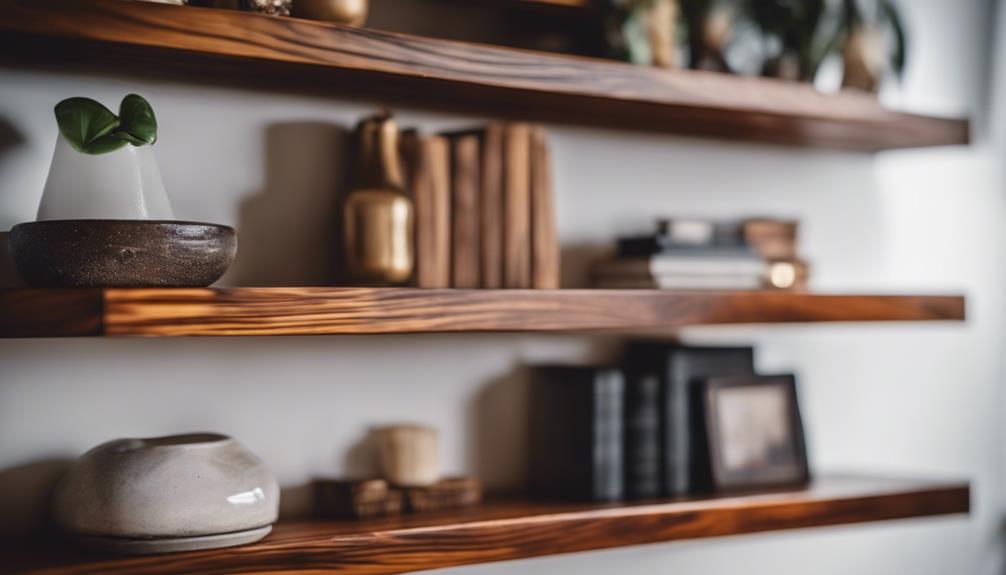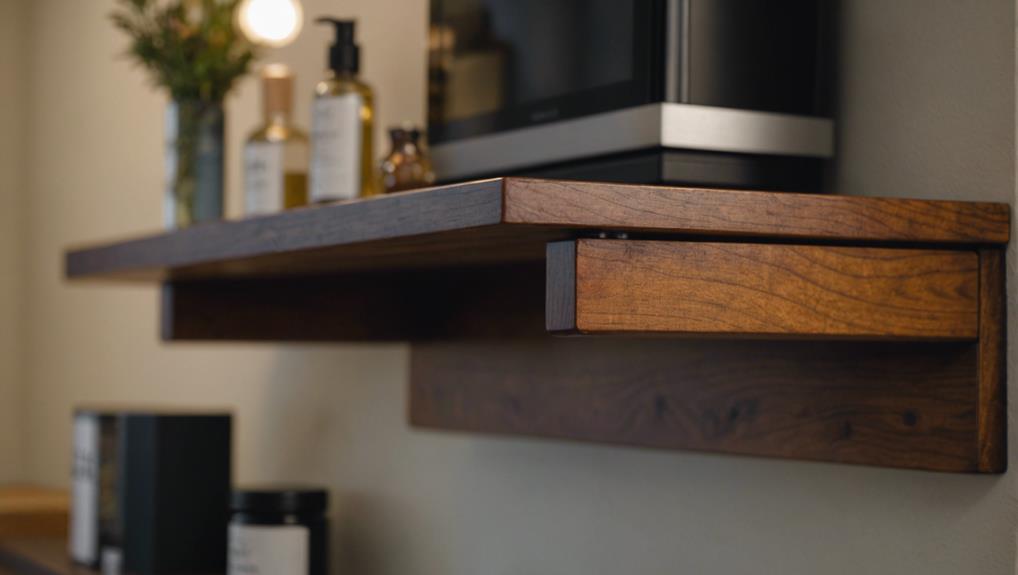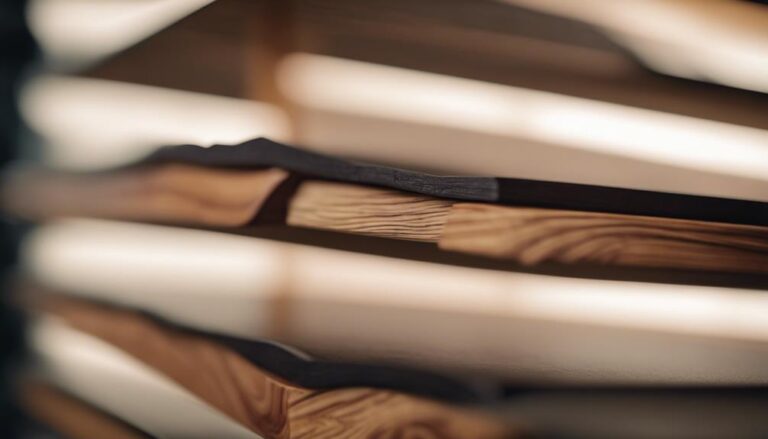Pros and Cons of Oil-Based Wood Finishes for Floating Wood Shelves

Choosing oil-based wood finishes for floating shelves enhances the natural grain, creates deep aesthetics, and provides long-lasting protection. These finishes deeply penetrate the wood, offering superior durability and defense against moisture and scratches. The application process is straightforward – simply apply an even coat, wipe off any excess, and allow for proper drying time.
One drawback to consider is the drying time. It can take up to 24 hours for the finish to dry, with full curing extending to 30 days. Additionally, there is the issue of volatile organic compound (VOC) emissions, which can have negative impacts on both health and the environment. However, opting for low-VOC options can help mitigate these concerns.
Overall, oil-based finishes are robust and can be eco-friendly if chosen wisely.
When maintaining floating wood shelves with oil-based finishes, it's important to consider the environmental impact and opt for sustainable, low-VOC options. By making informed choices, you can enjoy the aesthetic benefits of oil-based finishes while minimizing their environmental footprint.
Key Takeaways
- Pro: Oil-based finishes accentuate the natural wood grain, imparting a luxurious aesthetic to floating shelves. This enhances the overall look of the shelves, making them a stylish addition to any space.
- Pro: These finishes offer exceptional durability, making them well-suited for areas with high foot traffic. The longevity of oil-based finishes ensures that the floating shelves maintain their appearance and functionality over an extended period.
- Con: Volatile organic compound (VOC) emissions from oil-based finishes can lead to indoor air pollution, potentially causing health issues. It is important to consider the impact of these emissions on indoor air quality when using oil-based finishes for floating wood shelves.
- Con: The drying and curing times of oil-based finishes are relatively long, often requiring up to 30 days for full durability. This extended curing period may pose challenges for those who require immediate use of the shelves or have limited time for the finishing process.
- Pro: Oil-based finishes provide robust protection against moisture, scratches, and other forms of damage. By creating a protective barrier on the surface of the wood, these finishes help to extend the lifespan of floating shelves, ensuring they remain in top condition for a longer period.
Benefits of Oil-Based Finishes
Oil-based finishes enhance the natural grain of wood, giving floating wood shelves a luxurious and profound appearance. Opting for these finishes not only focuses on immediate visual appeal but also prioritizes long-term durability. These finishes penetrate deeply into the wood, ensuring that the vibrant natural grain remains prominently displayed while providing a robust finish that can withstand the test of time.
By utilizing oil-based finishes, we shield our wood from the detrimental effects of moisture and sunlight, two common factors that can deteriorate wood quality. The finish acts as a protective barrier that safeguards the shelves, preserving their elegance and structural integrity. This investment ensures that we not only enhance the aesthetic appeal of our floating wood shelves but also reinforce their durability.
Furthermore, the versatility of oil-based finishes allows them to bond seamlessly with both bare and previously stained wood. This feature provides us with the flexibility to easily refresh and maintain our shelves, guaranteeing consistent protection and appearance over the years. Choosing oil-based finishes is a strategic decision to uphold and elevate the visual and functional qualities of our floating wood shelves for the long haul.
Application Process
When applying the finish to floating wood shelves, a meticulous approach is essential to ensure uniform coverage and a flawless result. The process begins by selecting the preferred method, whether it be a brush or a rag. Each tool offers unique advantages, but the key is to ensure even coverage of the oil-based stains.
As the stain is applied, it's important to wipe away any excess to prevent drips and uneven spots that could affect the shelves' appearance.
After the initial coat is applied, it's crucial to respect the drying process. Rushing this step can result in smudges or imperfections, compromising the overall finish. Patience is key here, as allowing the stain to fully dry sets the foundation for a durable finish.
Moving on to sanding, lightly sanding the surface between coats creates a smoother texture and helps the subsequent layers adhere better. By repeating the staining process and following it with careful sanding, the desired appearance can be achieved.
Durability and Protection

To ensure the longevity and durability of our floating wood shelves, selecting oil-based wood finishes is key. These finishes are known for their strength and ability to protect the wood from moisture, scratches, and other potential damage, making them an ideal choice for high-traffic areas like floating shelves.
Oil-based finishes excel in resilience, maintaining the natural beauty of the wood while significantly extending its lifespan. The protective layer they create preserves the aesthetic appeal of the wood, ensuring that our floating shelves retain their charm and functionality for years to come.
The popularity of oil-based wood finishes in projects requiring robust protection is well-founded. For floating shelf installations exposed to daily wear and tear, these finishes act as a crucial safeguard. With proper application, they can significantly prolong the shelf's lifespan, making them a smart investment for any modern space.
Maintenance Requirements
Maintaining our floating wood shelves with oil-based finishes is a breeze, requiring minimal effort. These finishes are renowned for their low maintenance needs, providing a durable protective layer that shields the shelves from scratches, stains, and water damage. This means we can enjoy our shelves without the constant worry of refinishing.
Day-to-day care is as easy as a quick dusting to keep them looking their best. For deeper cleaning, a damp cloth is all that's typically needed to remove any dirt or smudges. This simple routine ensures our shelves maintain their aesthetic appeal without the need for constant attention.
To preserve the finish's beauty and integrity, it's advisable to reapply the oil-based finish every few years. This process refreshes the protective layer, keeping our shelves well-protected and visually pleasing as time goes on. The low maintenance aspect of oil-based finishes makes them perfect for those with busy schedules or commercial spaces that have limited time for upkeep.
Drying and Curing Times

When considering oil-based wood finishes for floating wood shelves, it's essential to understand the varying drying times involved. These drying times can range anywhere from 8 to 24 hours per coat, depending on the specific finish used. Furthermore, the complete curing process may take between 2 to 4 weeks before the shelves are fully ready for use.
Patience is key in allowing the finish to properly cure and harden for long-lasting durability. To manage these drying and curing times effectively, it's crucial to apply thin coats of the oil-based finish. This not only helps in achieving a smooth and even finish but also aids in quicker drying times between coats.
Additionally, monitoring environmental factors such as ventilation and humidity levels in the room can play a significant role in expediting the drying process. In conclusion, selecting the right oil-based wood finish for your floating wood shelves is just the beginning.
Understanding and being mindful of the drying and curing times involved can make a significant difference in the overall outcome. By following proper application techniques and taking environmental factors into account, you can ensure that your shelves are beautifully finished and ready for use in a timely manner.
Drying Time Variability
Drying times for oil-based wood finishes can vary significantly due to factors like temperature, humidity, and ventilation. This variability is crucial to consider when aiming for the ideal finish on our floating wooden shelves.
The drying time is mainly affected by:
- Temperature: Higher temperatures can hasten drying times, while lower temperatures slow down the process.
- Humidity: Elevated humidity levels can prolong drying times, whereas low humidity can expedite the process.
- Ventilation: Adequate airflow is essential; good ventilation can help quicken both drying and curing times.
Understanding these factors is key to making informed decisions and optimizing our workspace conditions for efficient finishing solutions.
Oil-based finishes typically become touch-dry within 8-24 hours, but this timeframe can vary significantly depending on our environment. Ensuring proper ventilation and maintaining consistent temperatures are essential strategies to effectively manage this variability.
Full Cure Duration
It usually takes around 30 days for oil-based wood finishes to fully cure on our floating wood shelves. While each coat dries within 8 to 10 hours initially, allowing for the ultimate durability and protection we seek requires patience throughout the entire curing process.
During the curing process, the finish hardens and forms a strong bond with the wood, creating a robust layer of defense against moisture, wear, and environmental factors. Proper ventilation and temperature control can help speed up drying times, ensuring each coat sets evenly and effectively.
Understanding the full cure duration is crucial for those looking to innovate and enhance the design of their floating wood shelves. Rushing this process can compromise the durability and protection of the shelves.
Application Waiting Period
Being patient during the curing process is crucial when it comes to wood finishes, especially for floating wood shelves. The waiting period after application is essential for allowing the finish to dry and cure properly. This period is particularly important for oil-based wood finishes, as it can greatly impact the durability and protection of the final result.
Typically, drying times can range from 8 to 24 hours before applying a second coat. However, to ensure maximum durability and protection, it's important to consider the curing time, which can extend up to 30 days.
To achieve the best results for your floating wood shelves, consider the following factors:
- Ventilation: Proper airflow is necessary for the drying process. Without adequate ventilation, the finish may not dry evenly, leading to potential imperfections.
- Temperature Control: Maintaining a stable temperature is crucial. Fluctuations in temperature can affect both the drying and curing times, potentially compromising the finish's quality.
- Manufacturer's Instructions: Following the guidelines provided by the manufacturer is essential. These instructions are designed to help you achieve the best possible results and avoid any mishaps during the finishing process.
Waiting for the finish to fully dry and cure before placing items on your floating wood shelves is key to preventing any marks or damage. By taking these steps and considering these factors, you can ensure a flawless, long-lasting finish that enhances both the beauty and functionality of your shelves.
Environmental Considerations
Considering the environmental impact of oil-based wood finishes in the context of floating wood shelf materials, it's crucial to address the volatile organic compound (VOC) emissions that can contribute to indoor air pollution.
Opting for low-VOC or VOC-free finishes can significantly minimize this impact, leading to a healthier indoor environment and a more sustainable choice for your shelves. Properly disposing of any unused finish containers is also essential to prevent environmental contamination.
When selecting wood finish options for your floating wood shelves, prioritizing low-VOC or VOC-free finishes can make a positive difference in reducing indoor air pollution levels and promoting a healthier living space.
VOC Emissions Impact
Oil-based wood finishes can enhance the beauty of floating wood shelves, but they often contain volatile organic compounds (VOCs) that can harm indoor air quality. VOC emissions impact our health by causing respiratory problems, headaches, and other issues. It's crucial to consider the environmental impact when selecting a wood finish for your shelves.
To reduce these risks, consider using low-VOC or zero-VOC oil-based finishes. These alternatives significantly decrease the release of harmful substances, creating a healthier living environment. By making this switch, you can achieve the following benefits:
- Improved Air Quality: Lowering VOC levels leads to cleaner air for you and your family.
- Enhanced Health: Decreasing exposure to toxic chemicals reduces the likelihood of health issues.
- Environmental Responsibility: Choosing eco-friendly products supports sustainability and reduces your carbon footprint.
Making conscious choices in selecting wood finishes for your floating shelves can have a positive impact on both your health and the environment.
Sustainability and Sourcing
When it comes to floating wood shelves, the choice of wood finishes plays a crucial role in both aesthetics and sustainability. Opting for oil-based finishes derived from natural oils like linseed, tung, or walnut not only enhances the beauty of the shelves but also supports eco-friendly woodworking practices. These finishes, sourced from renewable resources, showcase our commitment to sustainability and environmental responsibility. By selecting oil-based finishes from reputable suppliers, we ensure that our materials originate from sustainable forestry practices, ultimately reducing our overall environmental impact.
Sustainability holds significant importance in contemporary woodworking practices. Oil-based finishes contribute to the durability and longevity of wooden shelves, reducing the need for frequent replacements and minimizing waste. Our preference for finishes with low VOC content further emphasizes our dedication to eco-friendly practices, promoting better indoor air quality.
Embracing these oil-based finishes allows us to strike a balance between aesthetic appeal and environmental stewardship. By choosing sustainable wood finish options, we not only enhance the longevity of our products but also contribute to a healthier planet for future generations.
Frequently Asked Questions
What Are the Disadvantages of Oil Finish on Wood?
Oil finishes for floating wood shelves can present various challenges that may impact the overall quality of the project. The extended drying times of oil finishes can slow down the production process, delaying the completion of the floating wood shelves. Additionally, the strong odor emitted by oil finishes can be unpleasant and disruptive in the workspace, affecting the overall environment where the shelves are being constructed.
Furthermore, the application of oil finishes can result in a messy work area, requiring additional clean-up efforts to maintain a tidy workspace. The limited color options available with oil finishes may also restrict the design possibilities for the floating wood shelves, potentially limiting their aesthetic appeal.
In terms of maintenance, oil finishes require frequent upkeep to preserve the quality and appearance of the wood shelves over time. This regular maintenance schedule can add complexity to the project and increase the overall time and effort required to keep the shelves in optimal condition.
Considering these drawbacks, it may be beneficial to explore alternative wood finish options for floating wood shelves that offer quicker drying times, minimal odor, easy application, a wider range of color choices, and reduced maintenance requirements.
What Are the Best Wood Finishes for Shelves?
The best wood finishes for floating wood shelves provide a strong protective coating, enhance the natural beauty of the wood, and ensure resistance to water damage. Popular choices for finishing wood shelves are Danish oil and tung oil due to their ease of application and long-lasting durability.
Danish oil is a blend of varnish and oil that penetrates the wood to enhance its natural grain and color. It provides a warm, hand-rubbed finish that is both beautiful and protective. Tung oil, derived from the seeds of the tung tree, is another excellent option for finishing wood shelves. It creates a hard, waterproof finish that brings out the wood's natural richness and depth.
Both Danish oil and tung oil are great options for wood finishes because they are easy to apply and provide long-lasting protection. By choosing one of these finishes for your floating wood shelves, you can ensure that they not only look great but also stand up to daily wear and tear.
What Are the Disadvantages of Oil-Based Stains?
There are several drawbacks associated with oil-based stains when considering materials for floating wood shelves. These stains can be difficult to apply due to their viscosity, leading to uneven coverage and a less professional finish. Additionally, they have a longer drying time compared to water-based stains, which can delay the completion of your project.
Moreover, oil-based stains require more frequent maintenance to keep the shelves looking their best, as they are more prone to fading and wearing off over time. From an environmental standpoint, oil-based stains have a significant impact, as they contain harmful chemicals that can be released into the air during application and throughout the life of the shelves.
Lastly, the strong odor of oil-based stains can be unpleasant and linger for an extended period, making it less ideal for indoor projects where ventilation may be limited. Considering these factors, it may be worth exploring alternative wood finish options for your floating wood shelves that offer easier application, quicker drying times, lower maintenance requirements, and less environmental impact.
What Are the Cons of Oil Based Polyurethane?
Picture our shelves retaining a lingering scent due to the potent odor emitted by oil-based polyurethane. The extended drying time can be frustrating, leading to delays in completing your project. Additionally, the yellowing effect that occurs over time can alter the appearance of your wood shelves, affecting their aesthetic appeal.
Maintenance of shelves coated with oil-based polyurethane can be demanding, requiring frequent upkeep to preserve their appearance and durability. Moreover, the environmental impact of using oil-based polyurethane is a growing concern, as the production and disposal of this material can contribute to harmful emissions and environmental degradation.
Conclusion
In conclusion, oil-based wood finishes for floating wood shelves provide strong protection and enhance the shelves' appearance. They create a durable surface that showcases the natural beauty of the wood, as seen in a recent project where oak shelves were treated with this finish.
However, it's important to note that the application process requires precision and regular upkeep is necessary. Despite the longer drying times and the need for proper ventilation during application, the benefits of using oil-based finishes typically outweigh the drawbacks, making them a reliable choice for floating wood shelves.






